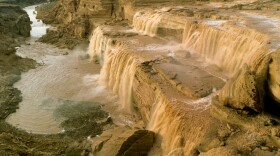If you stand at the brink of Toroweap Overlook and toss a penny into the Grand Canyon, the falling coin would hit the Colorado River two minutes later. If a park ranger is standing there, she’ll arrest you because your penny might bounce off a river runner approaching Lava Falls.
Two minutes. Three thousand feet. Straight down. Creep up to the edge, toes and fingers gripping every available crevice and cranny in the rimrock. If the wind is blowing just right, you can hear the waves crashing in Lava Falls. Go ahead, uncover your eyes, look into the abyss.
Years ago I worked down there, rowing boats. My rubber office was oar-powered, eighteen feet long. I took Lava Falls – the most notorious rapid in America – very seriously: the Ledge Hole, the V-Wave, the Humpback Chub. Monstrous waves, a maelstrom of crazy whitewater, a real chance that the boat would flip, that my passengers would swim.
At Toroweap, the beauty is jaw-dropping, framed by dark volcanic rocks. All around, lava poured from vents on the rim and frosted the steep cliffs into the Canyon. It must have been a hissing, seething spectacle when molten rock hit cold river. Basalt repeatedly filled the Canyon and created dams across the Colorado – some of them 2,300 feet high, backing lakes upstream as far as southern Utah.
It would be easy to assume that Lava Falls resulted from remnants of all that basalt out in the river. Do those lava dams explain what makes Lava Falls so spectacular, and so scary? Actually, no. Like most major rapids in Grand Canyon, Lava Falls was formed by rocks swept into to the river by floods from side canyons.
Look across to the other side, to a tributary called Prospect Canyon. You can see the black outline of basalt that made it across the river and up into Prospect 400,000 years ago. The Colorado was able to erode through the dam relatively quickly, but Prospect is still trying to cough that basalt out of its channel.
Prospect Canyon drains about 665 square miles – it can collect a lot of water during storms. Flashfloods leap over a thousand-foot cliff not far from the confluence with the Colorado River. Water shoots off that cliff like a firehose, then scours out tons of cobbles and huge boulders. The rock and water mix in a slurry like wet concrete, called a debris flow, that spews into the Colorado’s main channel. In the 20th century, six big debris flows came down Prospect – more than any other tributary in Grand Canyon.
Bob Webb, a US Geological Survey hydrologist, was camped at Lava on a rainy river trip in March 1995.
Webb and his crew decided the rapid was unrunnable. So they waited until the Colorado flushed most of the new obstruction downstream, then took their chances. They learned once again that Grand Canyon is subject to change without notice at the whims of rock and water.







